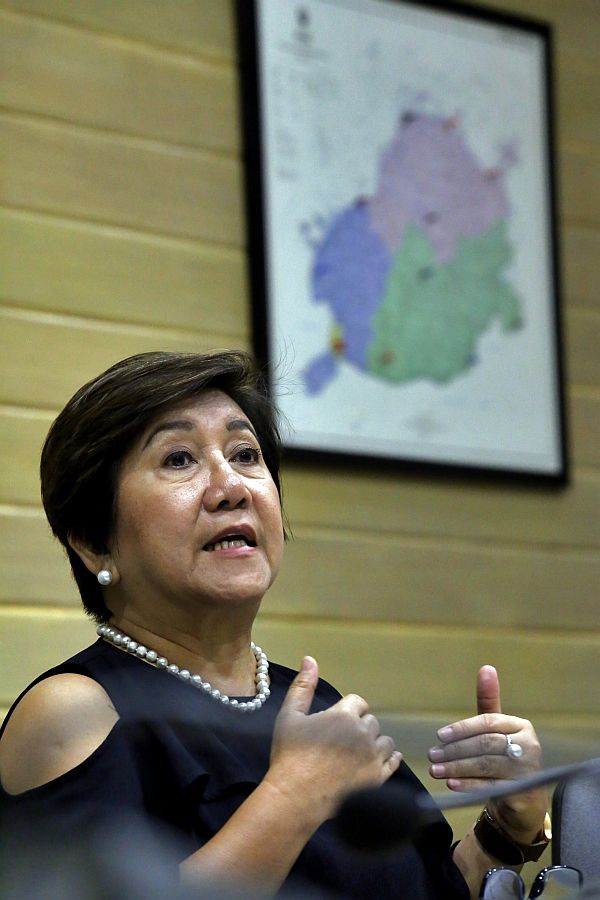
Director Asteria Caberte of the Department of Trade and Industry in Central Visayas (DTI-7) discusses the Sandugo Trade Festival in a press briefing at the DTI-7 office.
CDN PHOTO/JUNJIE MENDOZA
Biz leader emphasizes need to address traffic woes, lauds firm for ‘Creative Cebu’
How can Cebu attract more investors this year, surpass its nearly P30 billion worth of registered projects in 2016 and help sustain its economic growth?
For Cebu Chamber of Commerce and Industry (CCCI) President Melanie Ng, addressing Cebu’s traffic, which can help expedite the transport of goods, is a way to bring in investors.
Help from government agencies such as the Department of Trade and Industry in organizing trade fairs to help small entrepreneurs grow is another way to sustain the economy (see separate story).
Things that can promote Cebu like the investment guide, “Creative Cebu” highlighting Cebu’s creativity to show a better image of doing business in the Visayas and Mindanao areas, will also help.
Truck corridor
“With the growing economy, Cebu’s traffic will tend to worsen. We’re glad the four LGUs together with MCDCB (Metro Cebu Development Coordinating Board) has endorsed the Metro Cebu Truck Corridor. This will help alleviate traffic and expedite transport of goods,” Ng said when sought for a reaction on how to attract investors and sustain investments in Cebu.
“We also need an effective public transport to support the growth. That’s why the implementation of an effective mass transport system is badly needed,” she said.
She also welcomed the release of “Creative Cebu,” which is published by an advisory firm, PwC Philippines/Isla Lipana and Co., that takes a look at the the city’s culture, progress and potential as an investment destination.
“We are very appreciative of the laudable initiative of PWC in helping promote the investment attractiveness of Cebu. We are hopeful that this guide will provide the necessary impetus for the prospective investor to consider Cebu,” she said.
Registered projects
According to the Board of Investments (BOI), it registered P29.49 billion worth of projects in 2016, which is P3.89 billion more than P25.6 billion worth of registered projects in 2015.
“PwC has endeavored to package current local knowledge for prospective local and foreign investors,” Alexander Cabrera, PwC Philippines chairman and senior partner, said in the guide’s foreword.
Other than Cebu, the group also released guides titled “Burgeoning Bacolod,” “Inspiring Iloilo,” “Get into GenSan” (General Santos), “CDO (Cagayan de Oro), City of Awe,” and “Dauntless Davao,” which are available in their website.
In the 15-page guide for Cebu, PwC said that even with the distinction of being the oldest city in the Philippines, it has continued to reinvent itself over the years to adapt to the times.
That sensibility of being able to recreate lies at the heart of the latest developments in Cebu, PwC added.
Infrastructure
Infrastructure plays a major role in the growth of the local economy, with planned and ongoing projects such as the expansion of the Mactan-Cebu International Airport (MCIA), Bus Rapid Transit system, and the Cebu-Cordova Bridge seen to spur economic growth even further.
According to the guide, Cebu’s land could not support agriculture and instead evolved into a trading hub where merchants from all over Southeast Asia and China converged to engage in business.
“This explains how Cebuanos manage to create something out of nothing. Both that can-do attitude and indomitable spirit still prevail today,” PwC pointed out.
IT, BPO
Other areas that highlight the strength of Cebuanos are the growing business process outsourcing (BPO) and information technology (IT) industries.
Combined, these industries employ more than 100,000 persons, with the city targeting a 20 percent market share of all BPO services coming from the Philippines.
Aside from the IT and BPO industries, the guide also pointed out other thriving economic drivers such as the local shipbuilding industry, real estate and property, as well as tourism.